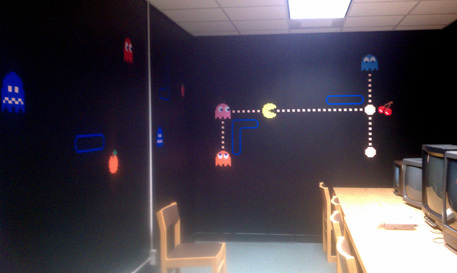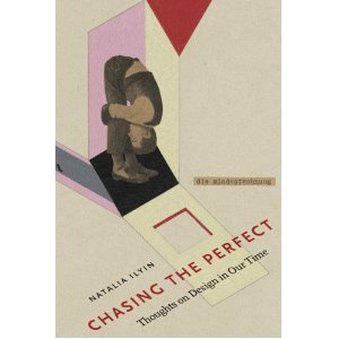 Among the many activities that force me to prime some impressive time-management skills (a steady diet of rock climbing, for example, or falling headfirst into a lesbian BDSM platformer video game), one of my favorites is working as an Assistant to the William A. Higinbotham Game Studies Collection. Over the past 3 years, I've been privileged to have a front row seat watching my dissertation advisor Raiford Guins build a video game lab from the ground up--often with his bare hands (I'm not kidding--he painted the walls himself). The WHGSC (unpronouncable!) is dedicated to preserving the legacy of William A. Higinbotham, with a special emphasis on his 1950s creation Tennis for Two--the first (analog) computer game ever built. The connection here is Brookhaven National Laboratory, the government research site Higinbotham worked at (now subcontracted by the US Department of Energy), and which currently operates in partnership with Stony Brook University. That's right--video game history on Long Island! The Collection works somewhat in two halves--there's the collection "proper", which includes consoles, cartridges, boxes, manuals, strategy guides and thousands of late 1970s - early 1990s video game magazines. This "stuff" is under the auspices of SBU's Special Collections, and directly attended to by Kristen Nyitray, the Head of Special Collections. The more public/pedagogic front of the Collection is the Video Game Lab--a room in the library full of clunky tables and big ol' CRT screens where students in Stony Brook's various video game related classes can experience, let's say, playing games on an original ColecoVision, real console, cartridges and all (I also like to break in on bad days and kill an hour playing Super Mario World--it always sets the world aright). I've had a hand in all sorts of fun stuff at the archive, from cataloging magazines to cleaning consoles to doing archival work. Last week, however, was a new task--I was asked to put up some Pac-Man themed "decorations" in the game lab. My advisor left a cardboard tube of wall decals in my office mailbox, and I presumed this would all be pretty straightforward. Opening it, however, I realized there were 50-some individual pieces, and I spent about 90 minutes having a serious designer's dilemma in the lab (certainly one of my most ludicrous design experiences to date). However, I think it came out splendidly, and the room now vibes with a sense of fun and whimsy, rather than its once rather oppressive stark black walls (apologizes for the crappy cell phone photo). Each time the lab and the collection improve, I'm proud of what we've done here: building up an institutional presence, piece by piece, into something students love, and which reflects what one can really accomplish at a university with enough drive, enthusiasm, and long-term vision.  Today I had the distinct pleasure of teaching Natalia Ilyin's Chasing the Perfect in the college-level Graphic Design History class I've been teaching as an adjunct. Teaching graphic design history has been a curious and illuminating throwback to my prior, "almost-famous" life as a graphic design critic (a long tale for another blog day). As a scholar with a BFA in graphic design, an MA in English, a pending Ph.D. in Cultural Studies and a grad certificate in Women's Studies, I'm a pretty sloppy disciplinarian. Thus, I didn't bat an eyelash at putting a memoir as the capstone reading for my graphic design history syllabus. And thank god I didn't, because Chasing the Perfect was the perfect culmination to a long, trotting list of dead white Western men and the ever-so "important" designs they made. Forgive my snideness--it's not that they weren't important, but moreso, as Ilyin might phrase it, "at what cost have they been made important?" Throughout the book, Ilyin maps the controlling, masculine tactics of modern design against her own ironically observed and amusingly described life events. Ilyin raises a simple question: Do you design out of fear, or do you design out of love? The moderns, to her, especially Bauhaus founder Walter Gropius, designed out of fear, designed to build a utopia that would protect them from the horror and brutality they witnessed in WWI. What that wrought was an unsustainable belief that design could control the mess of life, and Ilyin tracks this tendency with witty aplomb through homes of the future, graphic design grad school, the empty offices of modernist furniture designers, and through her own psychic space--Ilyin's mental breakdown is given central space but isn't overloaded. It is written with the humor and clarity that only comes with mature distance and sincere self-observation. There's no victim here, just raw life. One moment in the book, however, particularly held my interest. Near the end of the book, Ilyin discusses the fallacy of linear history--the impression we are given that graphic design began in the caves of France and has only marched forward on an unalterable course. Describing the art history staple of the slide lecture, she writes: "These slides link together the unlinked. They make the design past appear seamless, premeditated, a logical progression out of the caves and into the sunlight. It is as though [...] a celestial plan of progression is borne out in those slides, and that it was only a matter of time, say, until Futurism developed from all that had gone before. Which is not true. Which is picking up only one thread of a wide weave" (115). My media studies brain perks up here--it's the practice of the slide lecture, the use of the carousel projector or power point presentation that presents a "seamless, premeditated, a logical progression" of all those images. In a wonderously clever turn, Ilyin's indites the foundation of art history teaching for misrepresenting history through its own mechanical/digital mode of presentation. As I asked my students "When I show you one slide, and then click to another slide, did you ever wonder what happened in that gap?" I know I'm going to re-arrange the hell out of my syllabus for this class when I teach it again, but Chasing the Perfect isn't going anywhere. It's the perfect companion to Meggs, and I'm not sure I can imagine graphic design history without it. |
Archives
March 2020
Categories
All
|
 RSS Feed
RSS Feed